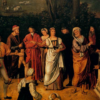A Brief History of Complementarian Literature
They say that the Reformation was a revolution not of weapons, but of words. The movement advanced through the preached Word and the written word in particular. Just as the Reformation constituted a mighty preaching and writing engine, so evangelical complementarianism has produced many millions of words that have revived and strengthened God’s church.
Should one desire to acquire a pastoral and theological foundation for a biblical view of manhood and womanhood, where does one begin? The following is a non-chronological crash-course in The Complementarian Writing Revolution (the books that pastors should read and gladly give away as resources).
The book that kicked it all off was Recovering Biblical Manhood & Womanhood (Crossway, 1991). It’s often called the “blue book” because this edition (the first of many) had a memorable (and friendly) light-blue shade. John Piper and Wayne Grudem edited the volume, with contributions from leading complementarians like Douglas Moo, D. A. Carson, Elisabeth Elliot, Dorothy Patterson, and Vern Poythress. The book is a theological masterpiece. It is still relevant and readable today, and if one wants a starting place to understand rock-ribbed, scholarly complementarianism, this is the place to start.
One further note about this scholarly text: it has given life to people. I heard from Louisville pastor Ryan Fullerton, for example, how RBMW opened his eyes to the beauty of biblical manhood and womanhood. Never assume that because a text traffics in high-level theology, it’s inaccessible to everyday concerns. The effect of RBMW in sustaining a generation—now two generations—of complementarians was simply massive.
Wayne Grudem has published multiple landmark books on complementarianism. Grudem’s writing is measured, biblical, and unafraid of convictional statement. He thinks logically and searchingly about everything he covers. His Evangelical Feminism & Biblical Truth (Crossway, 2004, 2012) answers basically every argument leveled against biblical gender roles. I used the book to prepare for a debate session with some folks and found they raised nearly ten of the objections Grudem’s text covers. On each point, I was fully ready to give a sound and logical biblical answer. I have heard Bruce Ware say that Grudem, his close friend, has almost singlehandedly represented the complementarian movement. Books like this—just one of numerous other volumes on the subject—show the truth of that judgement.
Ware, like Grudem a past President of the Council on Biblical Manhood & Womanhood, has contributed numerous journal articles and book chapters to scholarly complementarianism. His book on the Trinity entitled Father, Son, and Holy Spirit (Crossway, 2005) shows the necessary linkage between authority-submission relationships in the Godhead and authority-submission relationships in the church. Ware’s writing is readable and pastoral, though it covers some of the grandest doctrinal territory arrayed before the church. This view has been challenged (with Tom McCall forming the most vocal sparring partner), but the foundation laid in this book is very sturdy indeed.
Andreas Kostenberger recently published God’s Design for Man and Woman (Crossway, 2014) with his wife, Margaret Kostenberger; in fact, this book was reviewed in this Journal. The text is a rich biblical-theological approach to complementarianism that unfolds numerous passages of Scripture and places them within broader perspective. Both Kostenbergers have written numerous helpful resources in this area; Andreas’s book with Thomas R. Schreiner, Women in the Church: An Analysis and Application of 1 Timothy 2:9-15 (Baker 1995, 2005) has been called the definitive study of this contested but authoritative passage. Margaret has powerfully engaged feminist theology in her book Jesus and the Feminists (Crossway, 2008).
Mary Kassian has made huge contributions to evangelical scholarship and practice with her writings. The Feminist Mistake (Crossway, 2005) represents her own interaction with feminist theology and has proved helpful to many who have had little theological guidance on the issue. Kassian has started the TrueWoman conference with Nancy Leigh DeMoss, whose Lies Women Believe (Moody, 2006) has helped many women find their way out of unbiblical viewpoints. DeMoss wrote the foreword to Carolyn Mahaney’s Feminine Appeal (Crossway, 2012), which articulated the beauty of complementarianism to many thousands of women. Mahaney’s GirlTalk blog (written with her daughters) and the TrueWoman website are each excellent resources for godly women who love biblical teaching and find no offense in it.
Tim and Kathy Keller have written a much-loved book entitled The Meaning of Marriage (Dutton, 2011) that has done a great deal to advance a complementarian view of marriage. Tim has taken a great deal of heat for being a complementarian over the years, but has bravely stood firm in the trustworthy word. His preaching, like Piper’s, is one of the central reasons for the spread of complementarian theology among the “young, restless, and reformed” crowd. Kathy Keller’s book Jesus, Justice, and Gender Roles (Zondervan, 2012) showcases her strong mind and ability to foresee tough issues on the horizon. The issue of “gender justice” is a live one in our world and demands a good gospel answer.
There are many books to name that have made serious contributions to the church. Danny Akin’s God on Sex (B&H, 2003) is an honest and practical look at the goodness of covenantal union. Eric Mason’s Manhood Restored (B&H, 2013) is a strong and accessible introduction to the subject of manhood, much like Darrin Patrick’s The Dude’s Guide to Manhood (Thomas Nelson, 2013). Randy Stinson and Dan Dumas offer sound practical reflections in A Guide to Biblical Manhood (SBTS, 2011). J. Ligon Duncan and Susan Hunt yield needed wisdom in their book Women’s Ministry in the Local Church (Crossway, 2006). Gloria Furman is an eloquent writer whose book Glimpses of Grace (Crossway, 2013) found an enthusiastic audience, as did Rachel Jankovic’s Loving the Little Years (Canon, 2010), to name just two titles from these prolific authors.
Mark Chanski’s Manly Dominion (Calvary Press, 2007) and Womanly Dominion (Calvary Press, 2008) each lend valuable perspective to a robust complementarian theology. Steve and Candice Watters have written Start Your Family (Moody, 2008), which gives valuable guidance on a controverted subject. Carolyn McCulley’s Radical Womanhood (Moody, 2008) gives winsome and faithful voice to the experience of single complementarian Christians, as does Jennifer Marshall’s Now and Not Yet (Multnomah, 2007). Matt Chandler (with Jared Wilson) has just published The Mingling of Souls (David C. Cook, 2015), which will no doubt find an enthusiastic audience due to its winsome conviction, as will David Platt’s Counter Culture (Tyndale, 2015). Denny Burk has written a very helpful book in What Is the Meaning of Sex? (Crossway, 2013) to follow on his numerous contributions for the Journal for Biblical Manhood & Womanhood, which he edited for nearly a decade, and which is and has been the top academic resource on complementarianism in the scholarly community for nearly three decades.
JBMW can be found on the website of the Council on Biblical & Manhood (cbmw.org), the organization established in the late-1980s to promote a vibrant and unblinking vision of the goodness of God’s design. Other strong complementarian online outfits include Desiring God Ministries, 9Marks Ministries, The Gospel Coalition, Together for the Gospel, Ligonier, Grace to You, Revive Our Hearts, to name a few. The online presence of R. Albert Mohler, Jr. deserves special mention here, as does his booklet From Boy to Man, easily one of the best resources on training boys to be men.
CBMW is hard at work to raise up a fresh generation of gospel-gripped authors to articulate complementarian convictions in a winsome way. Designed for Joy (Crossway, 2015) was edited by Jonathan Parnell and Owen Strachan and features a bevy of young complementarians excited to celebrate God’s anthropological wisdom. Courtney Reissig’s The Accidental Feminist (Crossway, 2015) details her journey from feminism to complementarianism.
The preceding shows that complementarianism has been powered by many millions of words. The future, by God’s grace, is very bright, and is limned with the promise of many millions to come. Perhaps the central indicator of health for complementarianism as a movement is that all these words–in all these and many forthcoming books–are not only read, but are preached. It is because of tens of thousands of local churches that believe that God’s design for men and women is so irrepressibly good that the movement has not died out, as some predicted, but is teeming with health, and trained like a laser on the glory of God.
As in movements past, so may it be in this one in days to come.








